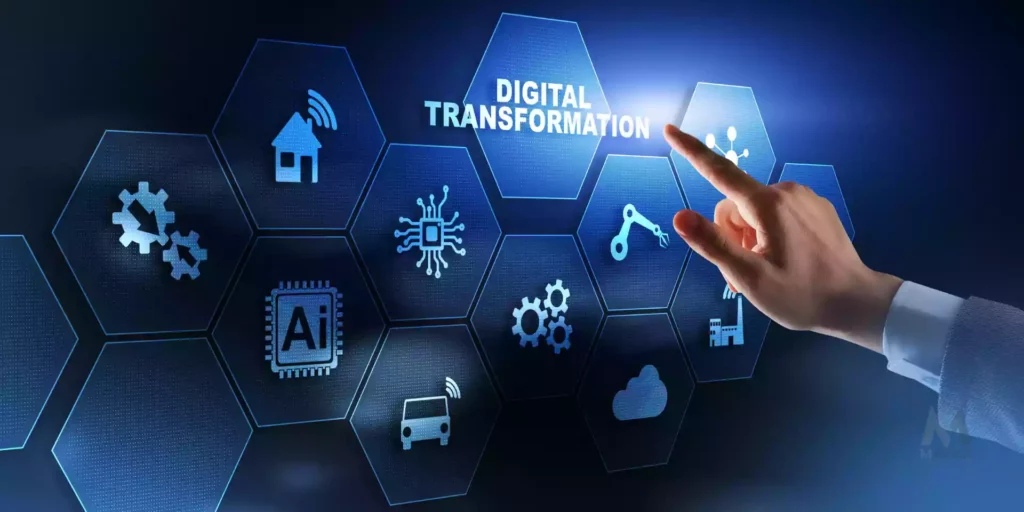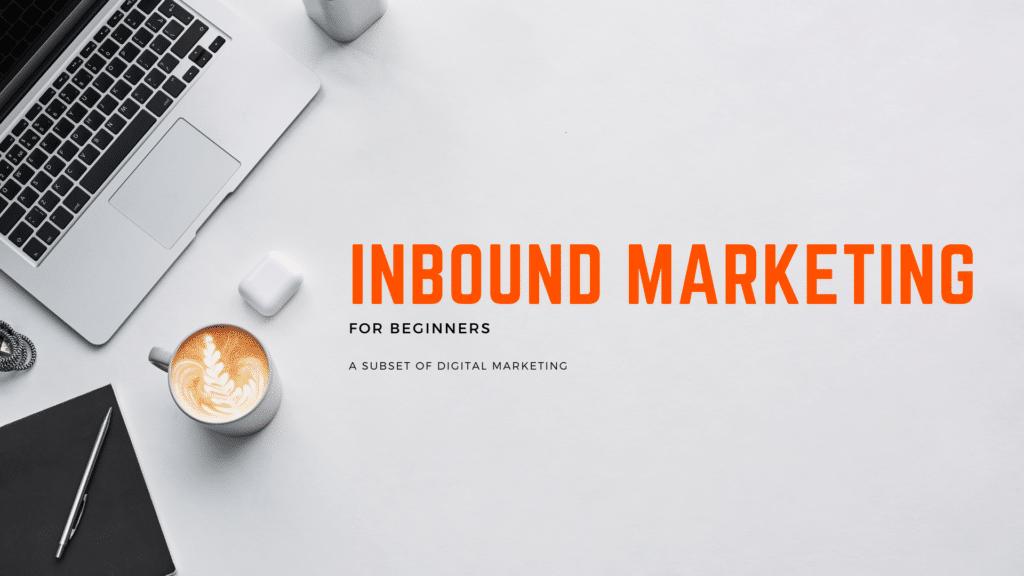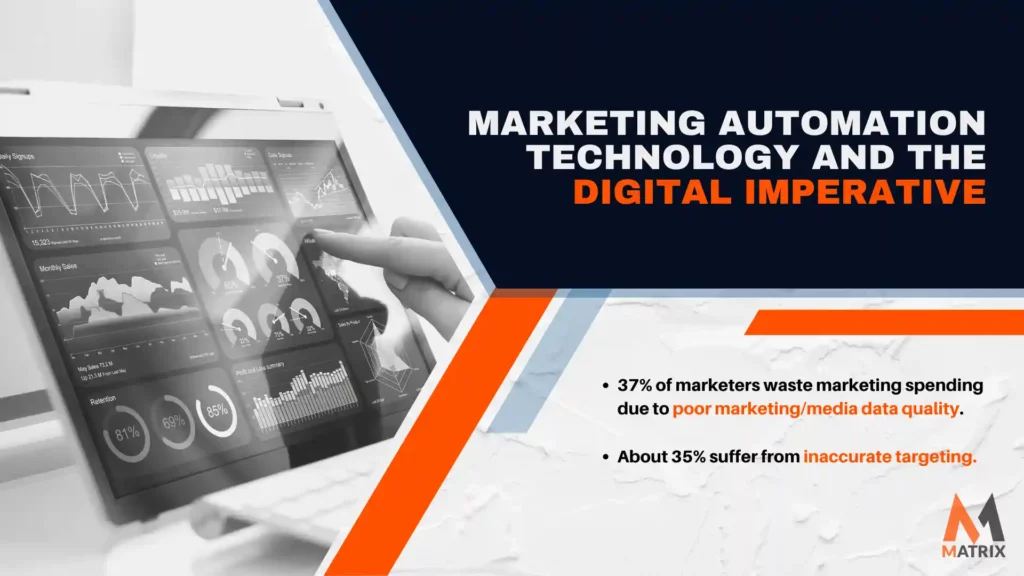The digital imperative is about rethinking your business model and leveraging marketing automation technology
What if you could use marketing automation technology to eliminate waste and boost sales. Would you do it? I did.
The digital imperative is about how small and medium-sized businesses can leverage sales and marketing automation technology to survive and thrive in a down economy or a good one.
You must rethink how your sales and marketing operations have been running and how to make it better with less.
Companies and organizations of all sizes are rethinking their business strategy and structural operations. Some not by choice but survival.
What if you could find all the gaps in your sales funnel, you know the bottlenecks. And have them identified and corrected.
Results are constantly improving leading to more sales. It’s that simple.
What is marketing automation technology?
Marketing automation technology is a broad term used to describe software and platforms that automate marketing tasks.
This can include email marketing, social media campaigns, lead capture processes, and more.
Automation technology can save you time and money while helping you to achieve better results with your marketing efforts.
HubSpot is a marketing automation technology. HubSpot will not increase your sales. Try it. Turn it on and see what happens. Nothing.
We have clients that come to use after installing HubSpot and say, “HubSpot was supposed to increase sales.” Who sold you that?
Now, pair HubSpot technology with consulting and HubSpot professional service providers like Matrix Marketing Group and you’ve got horsepower.
Horsepower drive-by professionals with technology, design, content, research, and curious professionals looking to help.
What is marketing automation?
Marketing automation is a process that uses technology to automate certain marketing tasks.
This can include email marketing, social media campaigns, and lead capture processes.
Automation technology can save you time and money while helping you to achieve better results with your marketing efforts.
Pre- and Current COVID Business Environment
Just think back to a year ago and how things were. The children were going to school, you were going to work, you might have been flying on airplanes, marketing was humming along, and sales were great. And then the worldwide pandemic hit, COVID-19.
You can and should always have a contingency plan in place for a crisis, but a worldwide shutdown?
Now think of your life, your family, your friends, and your career. Today the kids are home, educational institutions are shut down, you can’t go out to your favorite restaurant, and you might be learning how to cook for the first time.
If you happen to venture out, you better have a mask and social distance. And that’s a funny word social distance because it wasn’t even in our vocabulary last year.
At least not mine. ZOOM wasn’t even in a lot of parents’ vocabulary until COVID-19. I think the new pocket-handkerchief will be a face mask. That’s a business idea.
Think about 6-months ago (2020), and most people had never heard of ZOOM. It is a new buzzword like Kleenex or inbound.
This is going to make a lot of structural and strategic changes in small and medium-sized businesses. What will this mean in the supercities, and what does it mean for suburban and rural areas? What if you didn’t have a high-speed internet connection? Or there was no broadband at all. 5G is coming, but it’s not here yet.
The change we see today has been pushed up by at least ten years or more. Some businesses were better prepared than others. It’s causing the company to rethink its strategy and structure. For some, it’s a seismic shift.
Telehealth, Fintech, SaaS firms, Edtech, robotics, AI, and other industries have been preparing for this for years. Their business models just got tested and proven quicker than expected.
If you are fortunate enough to get a PPP loan or maybe an unemployment check, you’re one of the lucky ones. Even if you qualified, you might still be waiting in line or receiving it into your account. Because many governmental systems are so inundated with requests, outdated systems were overloaded and crashed.
Did you know many governmental computer systems are still running COBOL? I’m not going to tell you my age, but I started writing computer code with COBOL and Fortran on punch cards.
I remember the rubber bands around the punch cards deck to keep them in order. But if you dropped the card deck, you were in trouble. Hours of coding in a pile on the ground. It’s worse than 52 pickups, and the cards were not numbered.
Digital Disruption vs Digital Imperative

Let’s switch back to my original topic, the digital imperative. I used to talk about Y2K and how companies needed to update their systems. In the 90s, I spoke about digitizing and streamlining their supply chains from the front office to the back office with ERP systems.
The industry has done a phenomenal job streamlining supply chains with KANBAN, lean manufacturing, and six-sigma practices. Why can’t the sales and marketing operations do the same?
This is not the case with sales and marketing teams in the SMB space. The marketing automation space has been ahead of the adoption rate in the SMBs space.
What surprised me today is that the sales and marketing organizations have not gone through the digital transformation as the manufacturing and supply chain has. You can ask the VP of sales or CMOs, and they will give you countless reasons why. But they don’t hold up.
It goes back to the old story that marketing creates leads, and I’m in sales. They don’t get my job, and the leads are garbage. Or it takes too much work to enter the data into the CRM system. Or we’ve implemented marketing automation platforms before, and it was never set up correctly, or nobody uses our marketing technology.
They don’t know how to use it. Typically it has been from a lack of training in tech and marketing. You probably have your own stories too. I’d love to hear them.
On the vendor side of the marketing automation systems, they’re selling you technology, charging you a quick implementation fee, and often walking away.
And good luck with that if you’ve never used marketing and sales technology before, understand your archetypes, buyer’s journeys, or written advertising copy that motivates a business action. Or maybe you’re just using old marketing technology like Microsoft Excel.
Marketing strategy is about how you connect with your customers. Marketing technology is an enabler of the marketing plan and execution. Some things can be automated, and others cannot. And it depends on how you implement the technology, whether it’s a multi-channel or omnichannel environment. It all depends.
The current sales and marketing automation ecosystem (MARTECH)
So I’ve watched over the years and talked with Scott Brinker, who puts together a MARTECH industry report. The report includes 8000 (2020) different types of technology in sales and marketing. There are about 350 tools, software, and platforms in the marketing automation space.
Yes, the tech ecosystem has 350 and 8,000 tools, apps, software, plugins, and platforms. WOW, that’s a lot of stuff. Good luck with selecting the right MARTECH stack. It is confusing for some, especially if you don’t live it.
The 350 marketing automation platforms will be consolidated over the next 18 months to 3 years. It’s already happening. Some will fold, others are bought out, while others thrive. I’ve already seen corporate raider’s activity, and Apple, Microsoft, and Google are picking up some smaller startups for lunch money.
Tuning the sales and marketing operation with marketing automation technology
Let’s get back to the digital imperative and look at what is happening at the street level. The CMOs have been asked to reduce their marketing budget by as much as 60%. This means ad budget cuts, staffing reductions, and other programs are cut or eliminated. So who is left attending the store?
Many CMOs, don’t know how to do what their staff is doing, and if they do, they just don’t have the time. Here is where marketing automation technology helps.
If you’ve ever heard of HubSpot, maybe you are related it to inbound. Inbound is nothing new, but many agencies started as inbound agencies.
I never really understood why. So the inbound marketing agencies try to sell you HubSpot with a bundle of services. But they have difficulty pairing marketing automation technology and marketing and sales alignment.
Typically a retainer per month. Some are great agencies, but many of them just don’t know what they’re doing and dropping like flies. I’ve witnessed the churn from HubSpot customers for years. It’s typically not the software, it’s a bit pricy. There are better alternatives like HubSpot marketing automation.
Many of those digital marketing agencies are going out of business or trying to hold on by a thread with some sort of funding from the government through an SBA loan or crawling back to their private equity money, asking for a lifeline. After all, what’s the alternative for them if they’ve never been through a down economy?
Economic Recovery: V Shape or Swoosh Recovery
It’s hard to predict economic outcomes over the next eighteen months to three years, but I can reflect on 1987 (black Monday), 2001 (.com era), and 2008 (great recession). Today’s economic crisis is different. But it has begun to expose flaws in how people operate in business, education, government, and society.
Today’s economic crisis has exposed many flaws in how people run and manage their businesses.
We are just starting to uncover structural and strategic issues within small and medium-sized businesses, educational institutions, government institutions, and how people work in general.
This has caused anxiety for everybody. If you don’t have anxiety, I’d say you’re tuned out. So give yourself a break; many of us deserve a break.
So as I reflect on what’s going on today, I see a huge opportunity. I’m not talking about digital disruption; it’s digital imperative now. You have to reexamine your business model. Getting support funding doesn’t fix structural flaws in a business model or marketing strategy. As my friend says from Villanova, “all bets are off.”
The digital imperative and digital transformation
The digital imperative is about survival and thriving. A digital imperative for CEOs, CFOs, the board of directors, staff, and private equity with their portfolios.
Marketing automation has been around for years, but it appears like it was just built yesterday for some organizations. Why have they not implemented it before, maybe it failed due to poor implementation, or no one maintained the platform? They never got an ROI, and this makes no sense.
Leading-edge companies have a leg up on some pragmatic firms and laggards. If you haven’t read Geoffrey Moore’s books called Crossing the Chasm, The Gorilla Game, Inside the Tornado, and Escape Velocity.
The E-Myth a great book. The book is about the entrepreneurial myth, you know, the myth that most people who start small businesses are entrepreneurs and assume that an individual who understands the technical work of a company can successfully run a business that does that technical work. If you haven’t already, you should read these books.
Connect with your customers better with marketing automation technology.

Many people will tell you that if you just automate your sales and marketing, you will save a lot of money and staff, set it up, and leave it while automating everything. That’s nonsense. You can damage your brand by doing that. But if you do it right, you can survive in a down economy and thrive.
Have you ever got an email that’s talking about another type of persona (not your situation) that doesn’t even relate to you? I get calls all the time saying, hey, are you responsible for your telecommunication system? Our product can handle up to 2000 employees. Or would you like to outsource all your marketing to this organization out of Ireland?
These don’t even relate to me. These reps didn’t do their homework, and it’s lazy marketing.
Or if you got the email from gmail.com, hotmail.com, or aol.com. If you think those build trust, we need to talk.
The digital imperative has hit the micro-business and SMBs hard. This includes educational and government institutions as well.
The digital imperative is changing how we learn, how we deliver products and services, how we market, and how we sell. Whether you like it or not. You can choose to ignore it, put your head in the sand, or capitalize on it.
You must rethink your business model and how you run your organization.
The worldwide pandemic, COVID-19, will not be our last crisis.
Let me tell you a short story. I was hired to help an HP spinoff called CoCreate Software. Carly Fiorina was the CEO of HP at the time and wanted to spin off about 50 or so business units and technology to raise cash.
So, I spent about three months rebranding the company and relaunched it on 9/10/2001. Guess what happened on 9/11/01? Could I have seen that coming? I argue no. I could not have predicted the virus, either, could you?
But we must have contingency plans for the unexpected. CoCreate Software eventually recovers with the sale of the company to PTC in an exit strategy.
As restaurants and resorts, salons, spas, retail, and hotels open up, people will hesitate to go out or jump on a plane.
Many businesses will be hesitant to spend any money without a significant return on investment. Many of these organizations just don’t have the staff anymore as they tried to hold on to them through the PPP, which might get them through a month or two. Unfortunately, they may have to cut the cord and either furlough or lay off their employees.
Even in a down economy, you still have to do marketing and sales. So, who will do the work if you’ve done a downsize or the right size?
Once you cut the cord with an employee, it’s hard to plug them back into the wall. It’s a tough time in this crisis, and we all must be compassionate and care for one another. It’s in my DNA to help these employees that have been laid off and struggling businesses.
Let me go back to telehealth for a little bit. I’ve always thought it made more sense to jump on a video call, similar to a Google Meet or ZOOM, for a simple doctor check-in. I did it recently, and it went smoothly. The log-in process was easy with my doctor. Everything was fine. I think it bothered my doctor more than it bothered me. I’ve been doing these since 1997.
What I missed the most during this worldwide pandemic was social interaction being able to jump on a plane to meet with clients. Social media, online meetups, and virtual trade shows are tremendous, but it is not the same as having a meeting and looking somebody in the eye and shaking their hand.
You get to know the person, and body language can tell you a lot. I’ve seen some awkward meetings on Google Meet and ZOOM, but people are learning. Just don’t stand up; you never know what they are wearing.
For me, as a technologist, it’s an exciting time. I love technology, and I love to see people use technology in a manner that can make it more convenient for them to do business, make the company more efficient and effective, and easier to save time for the things that they love.
And that may be taking a walk with your dog, reflecting or doing some coding on a new project, and or just having that alone time in the morning with your favorite cup of coffee or tea. You know what I mean, that special moment.
The digital imperative is about how you can look at what has occurred and occurred in your life and business over the last two to three months (Q2FY20), how can technologies make your life easier, your team’s life easier, and your business more profitable. But it goes beyond that.
Using technology, whether multi-channel or omnichannel, is about connecting with your stakeholder and making the connection, experience frictionless, and better for them.
Think about ways to pair marketing automation with your marketing strategy to allow you to get more done, connect with the customers, and delight them. Do not bombard your customers with useless information they never requested nor care about. It’s about them, not you.
Give your prospects and customers what they want, when they want it, where they want it, and on the platform they want to consume information.
But customer loyalty is built on trust, not technology. We measure our success in the eyes of the customer.
This was our mantra at Matrix Marketing Group for over 30 years.
I know I’m preaching to the choir for many people, but many small and midsize businesses could use a boost today.
So I recommend that the sales and marketing organizations dust off or look at some new marketing technology, like marketing automation, to help them recover, restart, and position themselves before they become outdated.
Just look at the governmental systems running COBOL languages. Remember my punch card story and COBOL. Cloud computing and the SaaS technology model have allowed us to implement technology faster, realize a quicker return on investment, and customize 1:1 touchpoints along the customer’s journey with your brand.
High-speed internet, the cloud, and people with no idea how to use sales and marketing technology have opened up a world of opportunities. A friend of mine told me the other day we’re not in the same boat, but we are in the same storm, and I got it.
Another friend told me that you don’t worry about water for your third-year seed when the barn is burning. You put the barn fire out. I somewhat agree with that, but now is the time to rethink your business models and how you can effectively return to profitability.
Digital transformation and marketing automation technology

You must rethink how you can run your business better, more frictionless, and more cost-effective.
Marketing automation will give you higher profits, but more importantly, it will allow you and your employees to work on what matters to your business, which may be growing it or increasing customer satisfaction. It’s not about digital transformation; it’s about a digital imperative.
If you haven’t already implemented sales and marketing technology, you are probably behind the curve, and your customer is with your competitor. When the marketing and sales technologies first came out, leading-edge companies were willing to take the risk. Typical with technology or any change.
They jumped on board with Tom Siebel and purchased sales enterprise software from his company, Siebel Systems. Some early adopters bought ACT or Goldmine, full disclosure. I used all of these back in the 90s.
In 1986, ACT! Introduced the business world to contact management software. Essentially a digital Rolodex, ACT! allowed for the efficient storage and organization of customer contact information. Goldmine and other vendors also released CMS programs throughout the 80s.
In 1993, Tom Siebel left Oracle to create Siebel Systems. While at Oracle, Siebel tried unsuccessfully to convince CEO Larry Ellison to package and sell their internal sales application as a standalone product. Siebel Systems quickly became the market’s leading sales force automation (SFA) provider.
In 2007, Salesforce created the next significant change in the CRM industry. Force.com introduced the world to cloud-based CRM. Force.com addressed the criticism that cloud-based applications weren’t customizable. We know it is Salesforce.com today.
Through the end of the first decade and up to the present day, cloud-based and SaaS CRM solutions continue to integrate more features like customer service and social CRM. Cloud-based and SaaS CRM solutions continue to gain popularity, primarily due to their lower initial cost and easy integration with mobile devices.
Today, about 350 marketing automation platforms, tools, and software exist.
These have been out for years, in fact, decades, so the bugs have been worked out, and the systems operate very smoothly. However, I caution that you make sure that you select the right implementation team, whether you’re doing it internally or externally. You need a team that can pair technology with your marketing strategy. Oftentimes the marketing strategy must be created before the technology is implemented. it’s the old MBA adage strategy before structure.
You need what I call a sherpa or guide. On May 29, 1953, Edmund Hillary and Sherpa Tenzing Norgay reached the 29,035-foot summit of Everest, becoming the first people to stand atop the world’s highest mountain. Journalists asked who was first to reach the top. Both responded that it was a team effort that made it possible.
Are you ready for the digital imperative?
We’re listening.
Have something to say about your thoughts on marketing automation technology and the digital imperative?
Share it with us on Facebook, Twitter, or LinkedIn.
General FAQs about marketing automation technology
What is marketing automation technology?
Marketing Automation is a process where technology is used to automate several repetitive tasks undertaken regularly in a marketing campaign. A tool that allows an individual to design, execute, and automate a time-bound marketing workflow can be called a Marketing Automation platform.
What is marketing automation used for?
Marketing automation uses software and web-based services to execute, manage, and automate marketing tasks and processes. It replaces manual and repetitive marketing processes [emails, social media, specific website actions] with purpose-built software and applications geared toward performance in a multichannel or omnichannel environment.
What is the top seven marketing automation platform?
Here are the top 7 marketing automation platforms.
1. HubSpot
2. Oracle Marketing Cloud
3. Adobe Marketing Cloud
4. Active Campaign
5. Salesforce Pardot
6. Marketo
You will not beat HubSpot and Matrix Marketing Group in the midmarket.
What is marketing technology (MARTECH)?
A marketing technology (martech) stack is the group of technologies that sales reps and marketers use to execute, analyze, and improve their marketing across the customer life cycle. The focus of marketing technologies is to improve internal collaboration, measure the impact of marketing activities, and reach customers in new ways in better ways.

